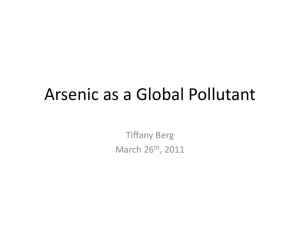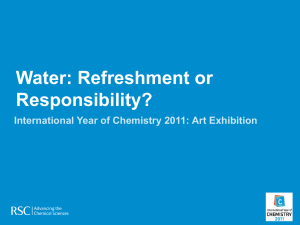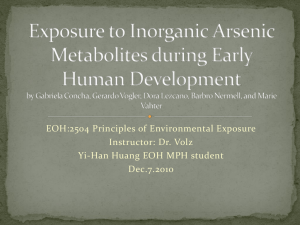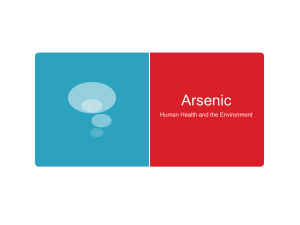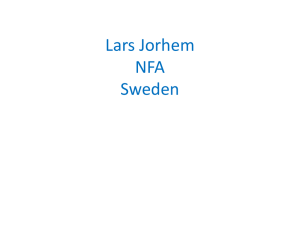toxic metals - CLU-IN
advertisement
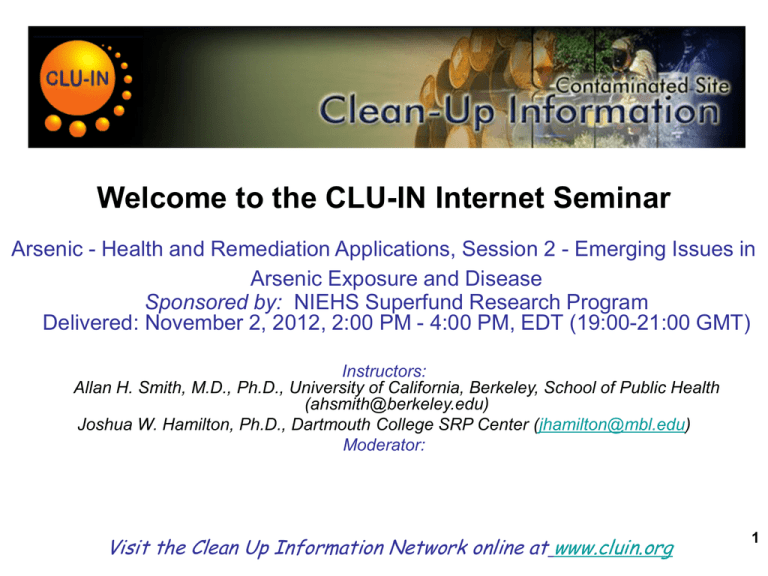
Welcome to the CLU-IN Internet Seminar Arsenic - Health and Remediation Applications, Session 2 - Emerging Issues in Arsenic Exposure and Disease Sponsored by: NIEHS Superfund Research Program Delivered: November 2, 2012, 2:00 PM - 4:00 PM, EDT (19:00-21:00 GMT) Instructors: Allan H. Smith, M.D., Ph.D., University of California, Berkeley, School of Public Health (ahsmith@berkeley.edu) Joshua W. Hamilton, Ph.D., Dartmouth College SRP Center (jhamilton@mbl.edu) Moderator: Visit the Clean Up Information Network online at www.cluin.org 1 Housekeeping • • • • Please mute your phone lines, Do NOT put this call on hold Q&A Turn off any pop-up blockers Move through slides using # links on left or buttons Download slides as PPT or PDF Go to slide 1 Move back 1 slide Move forward 1 slide Go to last slide Go to seminar homepage Submit comment or question Report technical problems • This event is being recorded • Archives accessed for free http://cluin.org/live/archive/ 2 The Astonishing Long-Term Effects of In Utero & Early Childhood Exposure to Arsenic Allan H. Smith MD, PhD Professor of Epidemiology University of California, Berkeley Recent findings from the Arsenic Health Effects Research Program With support from NIH including the NIEHS Superfund Program The Berkeley Arsenic Health Effects Research Group (ASRG) Arsenic Research Group Not Allan Smith’s Research Group Associate Director: Craig Steinmaus When I first started research on arsenic in water over 20 years ago, we only knew it caused skin lesions and skin cancer. Lung cancer and arsenic in Taiwan adapted from CJ Chen et al 1988 • Comparison population, all of Taiwan 9 8 7 6 all Taiwan 170 ug/L 470 ug/L 800 ug/L 5 4 3 2 1 0 women men • vertical axis: age adjusted rate ratios (relative risk) It is surprising that arsenic in drinking water would have major effects in the lungs Known causes of lung cancer involve inhalation • • • • • • smoking passive smoking asbestos radon silica chromium • • • • • diesel exhaust coke oven PAHs bischlormethyl ether nickel arsenic Cancer risks from arsenic in drinking water At the current standard of 50 ug/L, the lifetime risk of dying from cancer from drinking 1 L/day of water could be as high as 13 per 1000 persons Environmental Health Perspectives 97:259267, 1992 Martyn Smith The lost and forgotten arsenic-exposed population “the number of people consuming water from private wells with arsenic concentrations above 10 µg/L could be over 2 million people” Where is this population? Right here in the USA Steinmaus et al. In Press. There are high concentrations of arsenic in private wells in the U.S. too 500 Hach Field Test Kit Arsenic (g/L) Quick 400 300 200 100 0 -0 100 200 300 Laboratory Arsenic (g/L) Steinmaus CM, George CM, Kalman DA, Smith AH. Environ Sci Technology, 40:3362-3366, 2006 400 500 People with private wells are on their own 1000 900 800 Arsenic concentration (ug/L) 700 600 500 400 300 200 100 0 Pre-filter Post-filter Gearoge CM …… Steinmaus C. Arch Environ Occup Health 61:171-175, 2006. CHILE Region II Region V Lung Cancer Mortality Region II Chile, 1989-1993 Age Group 30-39 40-49 50-59 60-69 Women Observed Expected O/E 5 1.2 4.2 23 3.0 7.7 21 8.0 2.6 41 16.0 2.6 47 13.3 3.5 3.1 p<0.001 Men Observed Expected O/E 14 1.2 11.7 48 8.1 5.9 142 28.5 4.9 177 61.8 2.9 129 32.1 4.0 3.8 p<0.001 Smith Smith et AH al. American et al. American Journal Journal of Epidemiology, of Epidemiology, 1998. 1998. 70-79 SMR p value Mario Goycolea Lung Cancer and Inhalation of Arsenic 9 Lung cancer SMR 8 7 6 5 4 3 2 1 0 0 200 400 600 800 1000 Urinary arsenic (ug/l) Enterline PE et al, Am J Epidemiol 1987;125:929-38 1200 Lung cancer relative risk estimates from a case-contol study in Chile 9 (Ferreccio et al, Epidemiology, 2000) 8 7 Relative Risk 6 5 4 3 2 1 0 0 100 200 300 400 500 600 700 Water Arsenic Concentration 800 900 Increased lung cancer risks are similar whether arsenic is ingested or inhaled. 12.0 Relative Risk of Lung Cancer 10.0 8.0 6.0 4.0 Ingested A rsenic Inhaled A rsenic 2.0 Linear (Ingested A rsenic) Linear (Inhaled A rsenic) 0.0 0 200 400 600 800 1,000 1,200 1,400 Urinary Arsenic Concentration (g/Liter) Smith AH, Ercumen A, Yuan Y, Steinmaus CM.. J Exposure Science and Environmental Epidemiology 19:343-8, 2009 The estimated cancer risk at the drinking water standard of 50 µg/L for arsenic is more than 100 times greater than that for any other drinking water contaminant Smith AH, Lopipero PA, Bates MN, Steinmaus CM. Arsenic epidemiology and drinking water standards. Science 296: 2145-6, 2002 Cancer risk from contaminants in drinking water other than arsenic Per 100,000 14 12 10 8 6 4 2 0 Top of the list: Ethylene dibromide Cancer risk from contaminants in drinking water including arsenic Per 100,000 1400 1200 1000 800 600 400 200 0 Cancer risks from arsenic at the old drinking water standard were >100 times higher than the next highest risk contaminant Cancer risks from arsenic in drinking water Lung cancer and smoking • • • • 10 ug/L 50 ug/L 500 ug/L 5000 ug/L 1 in 500 die 1 in 100 die 1 in 10 die all die married to a smoker active smoker And arsenic in water looks good, does not smell and has no taste. So the risks are unbelievable Marshall G, Ferreccio C, et al. Fifty-year study of lung and bladder cancer mortality in Chile related to arsenic in drinking water. J Natl Cancer Inst 99:920-928, 2007 Mortality data were already available computerized for 1971-2000. For the years 1950-1971, 200,000 death certificates were digitally photographed and coded for this study. Mortality from lung cancer among men, Region II Chile Marshall et al, J. Natl Cancer Inst, 2007 5 Peak exposure 4 Rate Ratios started stopped 3 2 1 0 1950 1960 1970 1980 Year Rate ratios Lower 95% CI Upper 95% CI 1990 2000 So what do we now think arsenic in drinking water causes? • Respiratory Cancers of the lung and larynx, reduced lung function, bronchiectasis, chronic cough and shortness of breath. Tuberculosis mortality increased? • Renal tract Bladder and kidney cancer, chronic renal failure • Cardiovascular Myocardial infarction, cerebrovascular effects, hypertension. • Neurological Peripheral neuropathy, reduced cognitive function in children • Other Skin pigmentation changes, skin cancer, liver cancer, diabetes Effect of early life exposure In utero and in the first few years of childhood Source: Project Well, West Bengal, India, 2003 Arsenic concentrations in drinking water in the city of Antofagasta (popn 200,000) in Chile All childhood cancers 15 10 RR Boys Girls 5 0 1950-1957 1958-1970 1971-1981 Boys 1 0.7 0.9 Girls 1 1 1.2 Year of Birth Liaw J, et al Increased childhood liver cancer mortality and arsenic in drinking water in northern Chile. Cancer Epidemiol Biomarkers Prev. 2008. Liver cancer 15 p=0.01 10 RR Boys Girls 5 0 1950-1957 1958-1970 1971-1981 Boys 8.9 1.2 1.1 Girls 14.1 1.2 3.2 Year of Birth Lung cancer mortality in men according to exposure in childhood | born | | 1989 1998 peak arsenic | | | | | | 1950 1960 1970 1980 1990 2000 Lung cancer mortality in older men (SMR = standardized mortality ratio = observed/expected deaths) Age at death 60 – 69 | | 1989 1998 | born 1920-38 14 12 SMR 10 8 6 4 peak arsenic | | | | | | 1950 1960 1970 1980 1990 2000 2 0 rest Chile exposed p < 0.001 Lung cancer mortality in men according to exposure in childhood (SMR = standardized mortality ratio = observed/expected deaths) | born 1953-57 Age at death 35 – 39 | | 1989 1998 14 12 SMR 10 8 6 4 peak arsenic | | | | | | 1950 1960 1970 1980 1990 2000 2 0 rest Chile exposed p < 0.001 Lung cancer mortality in men according to exposure in childhood (SMR = standardized mortality ratio = observed/expected deaths) | born after 1957 Age at death 30 – 34 | | 1989 1998 14 12 SMR 10 8 6 4 peak arsenic | | | | | | 1950 1960 1970 1980 1990 2000 2 0 rest Chile exposed p < 0.001 Childhood exposures and young adult lung cancer relative risks 9 8 7 6 5 4 3 2 1 0 atom bomb ETS arsenic • Atomic bomb survivors Hiroshima and Nagasaki aged 10-20 in 1945. No cases in those exposed in utero or under age 10. • A study giving lung cancer relative risks in the age range 30-39 following many hours of daily passive smoking as children (only four cases). • Lung cancer relative risks in age range 30-39 in Region II of Chile following early life exposure to arsenic in water. There were 32 lung cancer deaths with 3.8 expected (RR=8.4, p<0.001). Smith AH et al. Environmental Health Perspectives 2006 End Stage Lung Disease Obstruction, Infection, Hemoptysis, Bronchiectasis High resolution computed tomography (HRCT) with readings in India and the United States without knowing who had arsenic skin lesions. Dr. D. N. Guha Mazumder Craig Steinmaus Study design, x-ray (HRCT) study in West Bengal, India 7600 surveyed Assessed in this study Referred for HRCT 108 selected with skin lesions and high arsenic exposure 150 selected with no skin lesions and low arsenic exposure 27 had chronic cough more than 2 years 11 had chronic cough More than 2 years 18 had evidence of bronchiectasis 3 had evidence of bronchiectasis 10-fold increased prevalence of bronchiectasis OR=10.1, p<0.01 Epidemiology 2005 Lung function findings of reduced FEV1 adjusted for age and height • For all men combined P=0.007 0 -50 -100 -150 -200 -250 -300 men skin men, lesions smoking women, skin lesions • Among men in this population, arsenic- caused skin lesions were associated with a greater FEV1 reduction (-256ml) than from smoking (-156ml) Von Ehrenstein OS et al. Am J Epidemiol 162: 533-41, 2005 Mortality (SMRs) from Chronic Obstructive Pulmonary Disease, age 30-49, for those born in the very high exposure period (in utero exposure) or just before (child) 50 45 40 35 30 25 20 15 10 5 0 All in utero child All COPD p<0.001 except other COPD p=0.004 50 45 40 35 30 25 20 15 10 5 0 All in utero child Bronchiectasis 50 45 40 35 30 25 20 15 10 5 0 All in utero child Other COPD A dugwell with modified design to reduce bacterial contamination Intervention program in West Bengal Director: Meera HiraSmith • Modern design dugwell program to provide arsenic free water in West Bengal • Funded by private donors • for more information http://www.projectwellusa.org 300 Distribution of Children’s Arsenic Exposure (ug/L) In Utero Number of Subjects (total=571) 250 200 150 100 50 0 0-9 10-99 100-299 300-499 500-699 Arsenic Categories 700-899 900-1099 1100+ Respiratory Symptoms for Which Adjusted* Odds Ratios for Highly Exposed Compared with Never Exposed In Utero are Greater Than 2 Never Exposed 10-499 ug/L 500+ ug/L 12 10 Odds Ratios 8 6 4 2 0 Wheeze ever Asthma Congested when Shortness of not having a cold breath when (last 12 months) walking fast or climbing Shortness of Wheeze when breath when not having a cold walking on level ground Respiratory Symptoms * Adjusted for age, gender, mother's education, father's education, father's smoking status and rooms in the house Excess deaths among men in Region II of Chile from acute MI, lung cancer and bladder cancer. Yuan Y et al. Am J Epidemiol 166:1381-1391, 2007 Acute Myocardial Infarction Lung Cancer Bladder Cancer 12 Male Excess deaths (%) 10 8 6 4 2 0 1950-1957 1958-1964 1965-1970 1971-1979 1980-1985 1986-1990 1991-1995 1996-2000 Years At the peak more than 1 in 10 of all deaths were due to arsenic Early life exposure and myocardial infarction mortality in young adults The highest rate ratios were for young adult men aged 30–49 years who were born during the high-exposure period with probable exposure in utero and in early childhood (rate ratio = 3.23, 95% CI: 2.79, 3.75; p < 0.001) Yuan Y et al. Am J Epidemiol 2007 Ecologic study of mortality of young adults aged 30-49 following exposure to high concentrations of arsenic in drinking water in early life (not yet published) CANCER MORTALITY Bladder Cancer SMR=21.3, p<0.001 Larynx Cancer SMR=10.5, p<0.001 Lung Cancer Rest of Chile SMR=6.8, p<0.001 Kidney Cancer Increased cancer mortality due to arsenic SMR=3.4, p<0.001 Liver Cancer SMR=3.1, p<0.001 Increased non-cancer mortality due to arsenic NON-CANCER MORTALITY Bronchiectasis SMR=25.1, p<0.001 Other COPD SMR=4.5, p<0.001 Chronic renal disease SMR=2.7, p<0.001 Acute myocardial infarction SMR=2.4, p<0.001 0 5 10 15 20 25 Standardized mortality ratios (SMRs) 30 Scientific plausibility Studies in mice by NIEHS have shown increased tumors in offspring of mice dosed with 85,000 ug/L, including bladder and lung tumors. (e.g. Tokar EJ, Diwan BA, Waalkes MP. Toxicology Letters 209:179– 185, 2012) The very high doses were given to achieve internal organ concentrations similar to highly exposed humans. Extrapolating risk to lower exposure • The exposures involved in Chile were to 850ug/L. • Some risks might be detectable by very large epidemiology studies with exposure around 100 ug/L • Even if there are risks at less than 50 ug/L, it is unlikely that epidemiological studies would ever find them • We need to think in terms of extrapolation of risks downwards and margins of safety Early life exposure to high concentrations of arsenic in water has major impact on young adult mortality beyond that from any other environmental exposure The END Note: Funding for these studies was provided by NIEHS research grants including the Superfund Research Program AND MOUSE MODELS OF HUMAN IN UTERO ADULT EXPOSURES TO LOW-DOSE ARSENIC Joshua W. Hamilton Ph.D. Senior Scientist, Bay Paul Center, Marine Biological Laboratory (MBL), Woods Hole MA Professor, Pathology & Laboratory Medicine, Brown University, Providence RI Project Leader, Dartmouth’s Superfund Research Program on Toxic Metals, Hanover NH JWH 4/8/2015 Arsenic and Old Concerns “It is an uncanny thought that this lurking poison (arsenic) is everywhere around us, ready to gain unsuspected entrance to our bodies in the food we eat, the water we drink and the air we breathe.” Karl Vogel, 1928 JWH 4/8/2015 METALS: Toxic Metals, Heavy Metals, Essential Metals • three-fourths of all elements are metals or metalloids • a “heavy metal” refers to its atomic weight, not its toxicity • many metals are essential or play a normal role in biology • many toxic metals that are not essential can mimic essential metals • like all chemicals, all metals are toxic at high enough doses • like all chemicals, all metals are non-toxic at very low doses JWH 4/8/2015 Toxic metals in the environment • Toxic metals are a major concern at both Superfund / toxic waste sites and in the environment in general • Eight of the top fifty substances on the CDC’s ATSDR priority list are metals, including the top three chemicals of concern in the environment: arsenic, lead and mercury • Eight of the twenty-two substances on the EPA’s OSWER list of chemicals of highest concern at Superfund sites are metals: arsenic, lead, mercury, cadmium, chromium, nickel, zinc and copper JWH 4/8/2015 Arsenic: “poison of kings and king of poisons” • • • Ancient Rome - Women’s club used arsenic to poison husbands Renaissance - The Borgias used arsenic to poison rivals and increase their wealth Were Napolean and Mozart poisoned by arsenic? Cesare Borgia “The death of Napolean” a lock of Napolean’s hair JWH 4/8/2015 Arsenic as an environmental contaminant • • • • • • Previous US and WHO drinking water standard (Maximum Contaminant Level, MCL) for arsenic was 50 parts per billion (ppb) from 1950’s through 2001 US recently lowered MCL to 10 ppb (Jan. 2006), but 7-14 year implementation current WHO and EU arsenic standard is 10 ppb WHO program of digging tube wells in India, Bangledesh to alleviate cholera problem led to massive population exposure to excess arsenic in drinking water highly contaminated areas (India, South America) can contain as much as 1800 ppb (180 times the WHO standard) Estimated 250 million to 1 billion people affected worldwide by excess arsenic JWH 4/8/2015 Arsenic as a causative agent in human disease • • • Chronic human exposure to inorganic arsenic at subacute doses has been linked to increased risk of: • Cancers- esp. lung, skin and bladder but also liver, kidney, and other malignancies • Diabetes (type 2, non-insulin-dependent, “adultonset”) • Vascular and cardiovascular disease • Reproductive and developmental problems • Neurological problems U.S. & South America - range is typically 1-100 ppb Asia - range is typically 10-1000 ppb JWH 4/8/2015 Arsenic as an environmental contaminant in New England • • • • • In New Hampshire, ~40% of the population gets its drinking water from private, unregulated wells Of these wells, greater than one in five has excess arsenic, representing about 10% of the state’s population (~120,000 people) Similar ratios are found in Maine (~150,000 people) In the U.S. as a whole, as many as 25 million people may be drinking excess arsenic in their drinking water NH and ME also have elevated levels of arsenic in soil both naturally and from lead arsenate pesticide use (avg. 20 ppm vs. 1-5 ppm in most of U.S.) JWH 4/8/2015 Center for Environmental Health Sciences at Dartmouth Project 7 - Carol Folt & Celia Chen ecotoxicology of metals Project 4 - Margaret Karagas epidemiology of arsenic Project 9 – Tracy Punshon & MaryLou Guerinot uptake of arsenic by rice Project 2 - Joshua Hamilton molecular toxicology of arsenic Project 8 - Bruce Stanton molecular toxicology of arsenic Dartmouth TOXIC METALS Research Program “Toxic Metals in the Northeast” NIH-NIEHS Sponsored Dartmouth Superfund Basic Research Program Project on Toxic Metals An interdisciplinary research program on toxic metals in the environment and their impact on ecosystems and human health JWH 4/8/2015 Arsenic as an endocrine disruptor What is an endocrine disruptor? “Collectively, chemicals with the potential to interfere with the function of endocrine systems are called endocrine disrupting chemicals (EDCs). EDCs have been defined as exogenous agents that interfere with the production, release, transport, metabolism, binding, action, or elimination of the natural hormones in the body responsible for the maintenance of homeostasis and the regulation of developmental processes.” 1998 Strategic Research Plan for Endocrine Disruptors, Office of Research and Development U.S. EPA JWH 4/8/2015 Hormone receptor biology and endocrine disruption organic Endocrine Disrupting Chemicals - EDCs (pesticides, etc.) competitive agonists mimic hormone, bind to receptor, activate receptor competitive antagonists mimic hormone, bind to receptor, block normal hormone binding and activation JWH 4/8/2015 Arsenic has opposite effects on steroid receptor function at lower (0.01-1.0 µM) and higher (2-3 µM) doses 2-2.5 fold enhancement 0.01-1 µM, 0.7-70 ppb No Observed Effect Level (NOEL) No Observed Effect Level (NOEL) 50-90% suppression 2-3 µM, 140-210 ppb JE Bodwell et al. Chem Res Toxicol 17:1064-1076, 2004 JWH 4/8/2015 Thyroid hormone mediated metamorphosis Xenopus Plasma TH Human Age (month) -6 -4 -2 0 2 4 6 8 10 12 14 Human 100 Xenopus 75 50 TR active 25 Xenopus Stage 35/36 45 51 55 58 61 63 66 As Premetamorphosis Prometamorphosis Metamorphic Climax YB Shi. et al.(2002) Pharmacol Ther 94:235-251 JWH 4/8/2015 Effects of arsenic on thyroid hormone-mediated ex vivo tail shrinkage in Xenopus JC Davey et al. Environ Hlth Perspect 116:165-172, 2008 JWH 4/8/2015 Summary of arsenic as an endocrine disruptor • • • • Arsenic affects all five steroid hormone receptors: • Estrogen Receptor • Progesterone Receptor • Androgen (Testosterone) Receptor • Glucocorticoid (Cortisol) Receptor • Mineralocorticoid (Aldosterone) Receptor Arsenic affects other nuclear hormone receptors: • Retinoic Acid Receptor • Thyroid Hormone Receptor • PPAR Receptors Arsenic enhances hormone signaling at very low doses Arsenic suppresses hormone signaling at higher doses JWH 4/8/2015 Arsenic and lung disease • • • Arsenic exposure is associated with increased risk of: • Lung Cancer • Bronchiectasis • COPD • Emphysema • Chronic Lung Infections Arsenic is unique in increasing lung disease risk via ingestion rather than (or in addition to) inhalation Arsenic synergistically increases risk of lung disease from other lung toxicants including tobacco smoke, environmental air contaminants, bacterial and viral infections JWH 4/8/2015 Arsenic and long-term risk of bronchiectasis in Region II of Chile Marshall, J Natl Canc Inst 2000 -- Ferreccio, Epidemiology 2000 -- Smith, Environ Hlth Perspect 2006 JWH 4/8/2015 Arsenic in drinking water (100 ppb) increases H1N1 flu-induced morbidity in mice CD Kozul et al., Environ Hlth Perspect 117: 1441-1447, 2009 JWH 4/8/2015 Arsenic and metabolic diseases • Arsenic exposure has been associated with: • Changes in serum cholesterol and triglycerides • Development of type 2 diabetes and other metabolic disorders • Lower than normal birth weights • Decreases in body weight and growth during early childhood • Vascular and cardiovascular disease JWH 4/8/2015 Effects of arsenic on mouse fetal and maternal health CD Kozul Horvath et al., PLoS One 2012 JWH 4/8/2015 Arsenic at 10 ppb in drinking water affects mouse fetal growth and development Pregnant C57BL/6J mice were given 10 ppb arsenic in drinking water during the in utero on post-natal weaning only, or in utero and post-natal periods CD Kozul Horvath et al., PLoS One 2012 JWH 4/8/2015 Arsenic at 10 ppb in drinking water affects mouse maternal breast milk nutrients Pregnant C57BL/6J mice were given 10 ppb arsenic in drinking water during the in utero on post-natal weaning only, or in utero and post-natal periods CD Kozul Horvath et al., PLoS One 2012 JWH 4/8/2015 Arsenic at 10 ppb in drinking water causes fatty liver in pregnant mice Pregnant C57BL/6J mice were given 10 ppb arsenic in drinking water during the in utero only, post-natal weaning only, or in utero and post-natal periods CD Kozul Horvath et al., PLoS One 2012 JWH 4/8/2015 Acknowledgements • Hamilton lab (past & present): • Collaborators: • Ron Kaltreider • Dean Wilcox (Dartmouth) • Mike Ihnat • Jack Bodwell (Dartmouth) • Jennifer Davey • Lynn Sheldon (Dartmouth) • Tom Hampton • Bruce Stanton (Dartmouth) • Athena Nomikos • Mike Ihnat (Oklahoma) • Julie Gosse • Richard Enelow • Courtney Kozul-Horvath (Dartmouth) • FJ Zandbergen • Monique Depaepe (Brown) • Vansa Chatikavanij • Maggie Vantangoli • Adeola Adebayo JWH 4/8/2015 Resources & Feedback • To view a complete list of resources for this seminar, please visit the Additional Resources • Please complete the Feedback Form to help ensure events like this are offered in the future Need confirmation of your participation today? Fill out the feedback form and check box for confirmation email. 79 New Ways to stay connected! • Follow CLU-IN on Facebook, LinkedIn, or Twitter https://www.facebook.com/EPACleanUpTech https://twitter.com/#!/EPACleanUpTech http://www.linkedin.com/groups/Clean-UpInformation-Network-CLUIN-4405740 80

